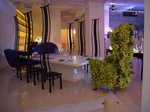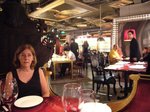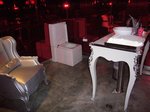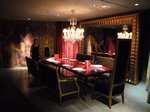SHANGHAI see other Shanghai trips
The Maglev (magnetic levitation) train runs
from Shanghai airport to Longyang Road Metro
Station. It travels very smoothly completing
the the 30Km in 8 minutes. It is capable
of commercial speeds up to 431km/h (286mph).
The aquarium is interesting with an underwater
glass tunnel so you can walk amongst the
fish. There’s a wide variety of aquatic
creatures from Asia to Africa and an excellent
shark tank. Apparently, it’s one of
Asia’s largest aquariums.
|
|
|
|
|
|
|
|
|
|
|
|
|
|
|
|
|
|
|
|
|
|
|
|
|
|
|
|
|
|
|
|
|
|
|
|
|
|
|
|
|
|
|
|
|
|
|
|
|
|
|
|
|
|
|
|
|
|
|
|
|
|
|
|
|
|
|
|
|
|
|
|
|
|
|
|
|
|
|
|
|
|
|
|
|
|
|
|
|
|
|
|
|
|
|
|
|
|
|
|
|
|
|
|
|
|
|
|
|
|
|
|
|
|
|
|
Shanghai to Beijing overnight train
Chinese trains are a safe and cheap way to
travel around China, although I would hold
back slightly in saying they are comfortable
but would rather say, adequate. It is a very
easy and convenient experience in contrast
to the bustle of the internal airport flights.
The only problem with the Chinese rail system
is that they don’t release the tickets
until 10 days before so planning your trip
around the country is difficult and you need
a plan B.We departed at 19.30 (be there 18.45,
Berth 21 & 23, carriage 1) and arrived
in Beijing at 7am the following day. (There
is now a new high speed train that travels
the 1,318km (819m) in 4hr 48 min (it is capable
of doing the journey in 3hr 58 min but the
government has restricted it).
BEIJING
Hutongs
Beijing's hutongs are more than just
architecture. They are the people who live
there. They are a museum of Beijing's
folk custom and they are a witness to the
city's history. At present, there
are about 4,550 hutongs, the broadest over
four meters wide and the smallest -- the
eastern part of Dongfu' an Hutong, a
mere 70 cm across -- just wide enough for
a single person to traverse. Although the
city has changed a great deal over the last
500 years, the hutongs remain much the same
as during Ming and Qing times.
Link to http://www.world.350.com/Hutongs/home.htm
Beijing Sihe hotel
This is an authentic Chinese experience in
the preserved and protected Hutong area.
The Beijing Courtyard Hotel SiHe is the only
hotel that was built at the beginning of
the Qing Dynasty. The design is based on
that used for ancient Chinese Imperial royalty.
It was the former residence of the famous
Chinese artist Mr. Mei Lan Fang. The rooms
surround a beautiful inner and outer quadrangle
courtyard and patio, and are decorated with
antique furniture carved with the dragon
and phoenix, which are the symbol of Chinese
ancient nobility.
We stayed in the principle room of the whole
quadrangle. It is located at the north side,
facing south. The bedroom area has a king-sized
flower-carved bed, antique side tables, a
bureau, a wardrobe, and palace lanterns.
The reception area (living room) is spacious
with two massive wooden armchairs, fit for
an emperor.
|
|
|
|
|
|
|
|
|
|
|
|
|
|
|
|
|
|
|
|
|
|
|
|
|
|
|
|
|
|
|
|
|
|
|
|
|
|
|
|
|
|
|
|
|
|
|
|
|
|
|
|
Beijing Urban Planning Exhibition Centre
This is a four-storey building set out as
a museum. The highlight is the detailed 3,200
square foot scaled model of Beijing that
projects what it will look like in 2020.
The theater shows two short films about the
‘Eternal City’ ie the history
of the construction of Beijing and about
the ‘New Beijing’ ie the present
and future state. There are two bronze models
of the natural geography of Beijing and of
Beijing in 1949 and also a museum room with
artefacts and maps in the hall.
Tiananmen Square
This third largest city square in the world
lies south of the Forbidden City. It has
great cultural significance as it was the
site of several important events in Chinese
history. Outside China, the square is best
known in recent memory as the focal point
of the Tiananmen Square protests of 1989,
a pro-democracy movement which ended on 4
June 1989 with the declaration of martial
law in Beijing by the government and the
death of several hundred civilians.
|
|
|
|
|
|
|
|
|
|
|
|
|
|
|
|
|
|
|
|
|
|
|
|
|
|
|
|
|
|
|
|
|
|
|
|
|
|
|
|
|
|
|
|
|
|
|
|
|
|
|
|
Mutianyu Great Wall is about 45 miles from Beijing. The wall
was first built in the Northern Qi Dynasty (550 - 557). In
the Ming Dynasty (1368 - 1644), Tan Lun and
Qi Jiguang, two famous patriotic generals,
rebuilt it in order to strengthen its defensive
potential when they guarded the strategic
pass. It served as the northern protective
screen, guarding the capital and imperial
mausoleums for generations. Mutianyu Great
Wall winds 1.4 miles through high mountains
and ridges, many sections of which are made
of granite. The unique structure makes the
wall almost indestructible. It measures 23
to 26 feet high and four to five yards wide.
Both of the wall's inner and outer sides
have parapets to defend against enemies coming
from the two sides. It has 22 watch towers.
At one point there is a cable car and a sled
for a speedy trip down!
798 Art District
798 is the site of state-owned factories
including Factory 798, which originally produced
electronics. Since 2002, artists and
cultural organizations have divided, rented
out, and re-made the factory spaces, gradually
developing them into galleries, art centers,
artists' studios, design companies, restaurants,
and bars. It is now a trendy, avant-garde
space with many high-level cultural, artistic
and commercial galleries and activities.
|
|
|
|
|
|
|
|
|
|
|
|
|
|
|
|
|
|
|
|
|
|
|
|
|
|
|
|
|
|
|
|
|
|
|
|
|
|
|
|
|
|
|
|
|
|
|
|
|
|
|
|
Restaurants
|
|
|
|
|
|
 |
| Green T House |
|
|
|
|
|
|
|
|
|
|
|
|
|
|
 |
| Lan Club |
|
|
|
|
|
|
|
|
|
|
|
|
|
|
 |
| Lan Club |
|
|
|
|
|
|
|
|
|
|
|
|
|
|
 |
| Lan Club |
|
|
|
|
|
|
|
|